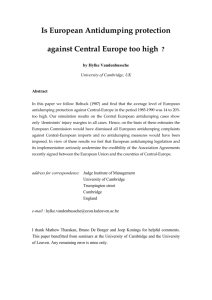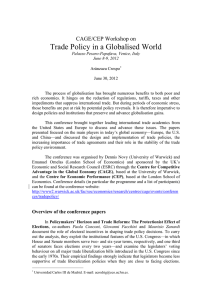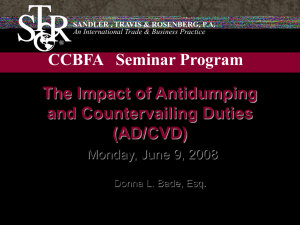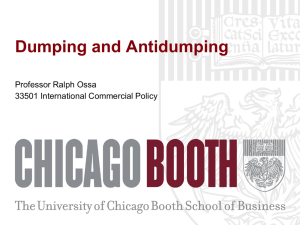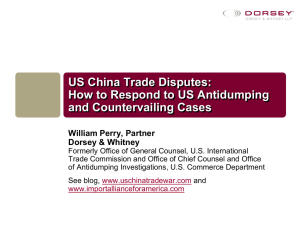International Journal of Application or Innovation in Engineering & Management... Web Site: www.ijaiem.org Email: Volume 3, Issue 6, June 2014
advertisement
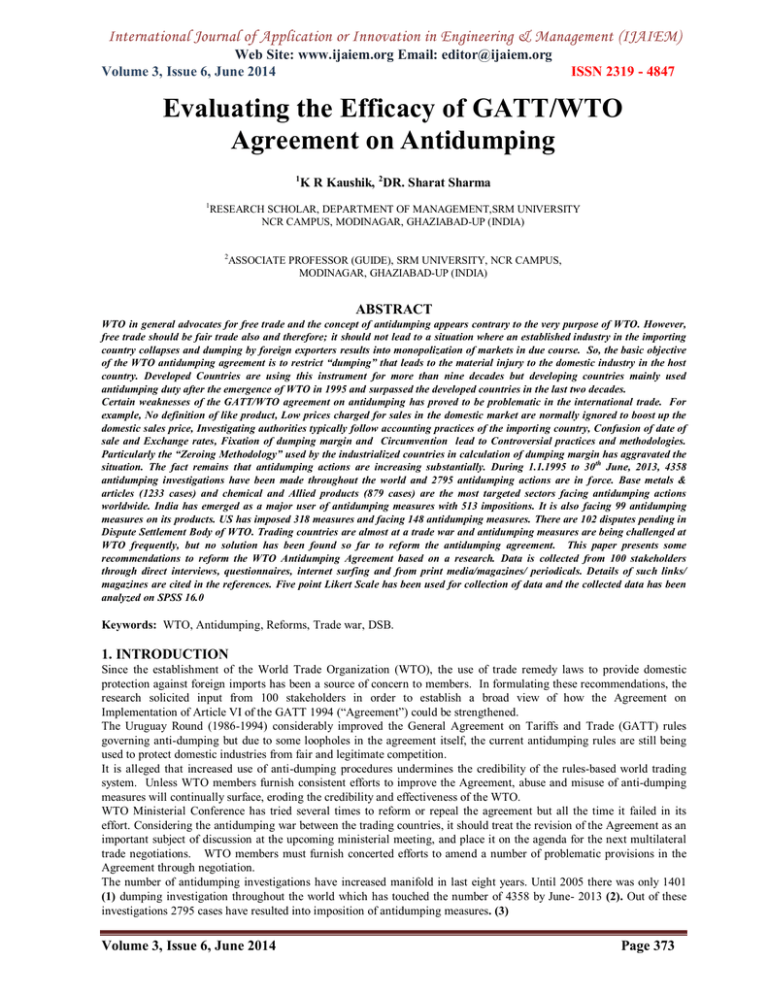
International Journal of Application or Innovation in Engineering & Management (IJAIEM) Web Site: www.ijaiem.org Email: editor@ijaiem.org Volume 3, Issue 6, June 2014 ISSN 2319 - 4847 Evaluating the Efficacy of GATT/WTO Agreement on Antidumping 1 1 K R Kaushik, 2DR. Sharat Sharma RESEARCH SCHOLAR, DEPARTMENT OF MANAGEMENT,SRM UNIVERSITY NCR CAMPUS, MODINAGAR, GHAZIABAD-UP (INDIA) 2 ASSOCIATE PROFESSOR (GUIDE), SRM UNIVERSITY, NCR CAMPUS, MODINAGAR, GHAZIABAD-UP (INDIA) ABSTRACT WTO in general advocates for free trade and the concept of antidumping appears contrary to the very purpose of WTO. However, free trade should be fair trade also and therefore; it should not lead to a situation where an established industry in the importing country collapses and dumping by foreign exporters results into monopolization of markets in due course. So, the basic objective of the WTO antidumping agreement is to restrict “dumping” that leads to the material injury to the domestic industry in the host country. Developed Countries are using this instrument for more than nine decades but developing countries mainly used antidumping duty after the emergence of WTO in 1995 and surpassed the developed countries in the last two decades. Certain weaknesses of the GATT/WTO agreement on antidumping has proved to be problematic in the international trade. For example, No definition of like product, Low prices charged for sales in the domestic market are normally ignored to boost up the domestic sales price, Investigating authorities typically follow accounting practices of the importing country, Confusion of date of sale and Exchange rates, Fixation of dumping margin and Circumvention lead to Controversial practices and methodologies. Particularly the “Zeroing Methodology” used by the industrialized countries in calculation of dumping margin has aggravated the situation. The fact remains that antidumping actions are increasing substantially. During 1.1.1995 to 30th June, 2013, 4358 antidumping investigations have been made throughout the world and 2795 antidumping actions are in force. Base metals & articles (1233 cases) and chemical and Allied products (879 cases) are the most targeted sectors facing antidumping actions worldwide. India has emerged as a major user of antidumping measures with 513 impositions. It is also facing 99 antidumping measures on its products. US has imposed 318 measures and facing 148 antidumping measures. There are 102 disputes pending in Dispute Settlement Body of WTO. Trading countries are almost at a trade war and antidumping measures are being challenged at WTO frequently, but no solution has been found so far to reform the antidumping agreement. This paper presents some recommendations to reform the WTO Antidumping Agreement based on a research. Data is collected from 100 stakeholders through direct interviews, questionnaires, internet surfing and from print media/magazines/ periodicals. Details of such links/ magazines are cited in the references. Five point Likert Scale has been used for collection of data and the collected data has been analyzed on SPSS 16.0 Keywords: WTO, Antidumping, Reforms, Trade war, DSB. 1. INTRODUCTION Since the establishment of the World Trade Organization (WTO), the use of trade remedy laws to provide domestic protection against foreign imports has been a source of concern to members. In formulating these recommendations, the research solicited input from 100 stakeholders in order to establish a broad view of how the Agreement on Implementation of Article VI of the GATT 1994 (“Agreement”) could be strengthened. The Uruguay Round (1986-1994) considerably improved the General Agreement on Tariffs and Trade (GATT) rules governing anti-dumping but due to some loopholes in the agreement itself, the current antidumping rules are still being used to protect domestic industries from fair and legitimate competition. It is alleged that increased use of anti-dumping procedures undermines the credibility of the rules-based world trading system. Unless WTO members furnish consistent efforts to improve the Agreement, abuse and misuse of anti-dumping measures will continually surface, eroding the credibility and effectiveness of the WTO. WTO Ministerial Conference has tried several times to reform or repeal the agreement but all the time it failed in its effort. Considering the antidumping war between the trading countries, it should treat the revision of the Agreement as an important subject of discussion at the upcoming ministerial meeting, and place it on the agenda for the next multilateral trade negotiations. WTO members must furnish concerted efforts to amend a number of problematic provisions in the Agreement through negotiation. The number of antidumping investigations have increased manifold in last eight years. Until 2005 there was only 1401 (1) dumping investigation throughout the world which has touched the number of 4358 by June- 2013 (2). Out of these investigations 2795 cases have resulted into imposition of antidumping measures. (3) Volume 3, Issue 6, June 2014 Page 373 International Journal of Application or Innovation in Engineering & Management (IJAIEM) Web Site: www.ijaiem.org Email: editor@ijaiem.org Volume 3, Issue 6, June 2014 ISSN 2319 - 4847 Significantly, 10 countries lead by India and US are responsible for 75% investigations and impositions. India investigated 690 antidumping cases and imposed 513 measures followed by US with 476 investigations and 318 antidumping measures between Jan-1995 to June-2013. (4) 1. Chad P. Bown antidumping data base 2005 2. Calculated from World Bank Antidumping data base -2013on antidumping investigations 3. Calculated from World Bank Antidumping database- 2013 on antidumping measures 4. Calculated from World Bank Antidumping data base -2013on antidumping investigations India investigated 150 cases of antidumping against China alone and 99 antidumping measures are in force against Chinese products (5). As of now 102 cases (6) of antidumping disputes are pending with the Dispute Settlement Body (DSB) IMPACT OF ANTIIDUMPING AGREEMENT ON TRADE Antidumping laws existed in the developed countries like Canada and US since beginning of the 20th century and even earlier in Europe, those laws were sparingly used. WTO allows members countries to frame their antidumping laws. Most of the Member countries of WTO has devised their antidumping laws based on the WTO antidumping agreement. On some of the clauses like: No definition of like product, Low prices charged for sales in the domestic market are normally ignored to boost up the domestic sales price, Investigating authorities typically follow accounting practices of the importing country, Confusion of date of sale and Exchange rates, Fixation of dumping margin and Circumvention lead to Controversial practices and methodologies. Particularly the “Zeroing Methodology” used by the industrialized countries in calculation of dumping margin has resulted in trade disputes and retaliation against each other. Consequently, in the recent times the number of antidumping cases rose manifold particularly, after the emergence of WTO in 1995. The main reason of increase in antidumping case seems to be the reduction in tariffs by the member countries and announcement of “BOUND RATES” where the maximum limit of tariffs is fixed and the countries are left with the option of the use of non-tariff barriers. Particularly the use of antidumping measures by member countries has become a real threat in the international trade. The last two and half decades have seen dramatic changes in terms of: (i) The number of antidumping initiations and antidumping measures in force, (ii) The number of antidumping users, and (iii) The number of countries and industries become targets of antidumping. 5. Calculated from World Bank Antidumping database- 2013 6. WTO website: Antidumping cases referred for reconciliation to Dispute Settlement Body-2013 7. The Economic Impact of the Canada-Chile Free Trade Agreement released by Office of the Chief Economist Foreign Affairs and International Trade Canada on May 30, 2013 Statistically, India is the top users of antidumping measures followed by US. India accounts for only 2% of the global exports but it is facing 4% of antidumping actions across the world. Also out of the 4358 antidumping investigations worldwide from Jan-1995 to June-2013, India is responsible for 690 investigations and imposition of took 513 antidumping measures. Similarly, US are responsible for 476 investigations and 318 antidumping measures for the same period leading to considerable restrictions and loss of trade. (8) U.S. is also facing 143 (9) antidumping actions on its products followed by India with 99 antidumping measures in force mainly from European Union, Canada, China. All these actions are potentially harmful to the international trade. Table-1 provides the country wise details These ten countries are responsible for 3245 investigations out of the total 4358 cases investigated during Jan.1995 to June-2013, which is over 74% of the total investigations carried during the period. Put together India and US are responsible for 1146 investigations out of the total 4358 investigations which means these two countries have investigated over 26% of the total investigations. (10) Table -2 shows the antidumping measures imposed by the top ten countries including India and US Volume 3, Issue 6, June 2014 Page 374 International Journal of Application or Innovation in Engineering & Management (IJAIEM) Web Site: www.ijaiem.org Email: editor@ijaiem.org Volume 3, Issue 6, June 2014 ISSN 2319 - 4847 From the above tables we can see that out of the total 2795 antidumping measures imposed between 1.1.1995 to 30.6.2013 the above mentioned 10 countries have taken 2106 measures i.e.75.3%. (India and USA put together counts for over 29% measures imposed ( total 820 measures out of the total 2795 measures) worldwide. (11) If we see worldwide sector wise initiations of antidumping investigations the most targeted sector is Base metals and articles with 1233 investigations out of total 4358 investigations carried out against this sector which is little over 27% of the total investigations. Next most targeted sector with 879 investigation out of total 4358 (almost 20%) is the products of chemicals and allied industries. (12) Resins, plastics and articles, rubber and articles are the other sector which has been targeted. 571 investigations out of total 4358 investigations have been carried against this sector which is over 12.5% of the total antidumping investigations followed by machinery and electric equipments (377 cases) and Textiles and articles (with 322 cases). 8, 9 Calculated from the World Bank Antidumping data base-2013- Sector wise initiations, antidumping measures by exporting countries 10,11. Calculated from the World Bank Antidumping data base-2013- Sector wise initiations, antidumping measures by exporting countries 12,13,14 Calculated from the World Bank Antidumping data base-2013- Sector wise initiations It is evident from these tables above that India initiated 41.5% antidumping investigations (287 out of 690) on chemicals and allied industries and imposed 232 measures on these products out of the total 513 measures which is over 45% of the total measures imposed by India. (13) Similarly, USA initiated most of its investigations towards Base Metals and Articles (242 out of total 476) and imposed 165 measures against this sector out of the total 318 antidumping measures taken by USA, which is almost 52% of the total antidumping measures. (14) It’s also interesting to note that four of the top 10 antidumping users (the India, United States, Brazil and Germany) also fell victim to the protectionism of other countries and appear in the top 10 targets in the same period. Among others Canada, Mexico United Kingdom and France are among the top 20 targets (15). In nut-shell antidumping duties have proved more harmful to the international trade compared to the tariffs and this does not seem to end in near future as most of the WTO members are in favour of the continuity of antidumping laws. Research has identified the major problematic areas of the WTO agreement on Antidumping which are briefly explained below: 13, 14 Calculated from the World Bank Antidumping data base-2013- Sector wise initiations by exporting countries 15 Calculated from the World Bank Antidumping data base-2013- Sector wise initiations by exporting countries BRIEF RESULTS OF DATA ANALYSIS The collected data has been analyzed on SPSS 16.0 Tool. Frequencies, Cross tables and Summaries has been drawn and final results of the data analysis have emerged as under: a) No obligation is determined on member countries to prevent the misuse of the agreement. b) Exceptional price comparison method is still being used while calculating the antidumping margin c) No Clear definition of domestic industry d) Chain Complaints still prevails particularly in the industrialized countries e) Different % age of De-Minims are used by member countries f) Most of the member countries are yet to include the Public Interest clause in their antidumping laws. g) A few countries follow the Lesser Duty Rule of Antidumping Agreement h) All the countries follow the 5 years period for Sun Set Review i) Ensure transparency in review procedures j) Strengthen the functions of the WTO panel. k) Introduce anti-circumvention regulations. l) Anti-dumping and Competition policy It is evident from the above results that WTO Antidumping agreement has many loopholes which are being manipulated by the member countries for their vested interests. Misuse of the agreement not only leads to the trade distortion, trade deviation or trade restriction but also results in retaliations against each other. To ensure the free and fair trade in the world the following reformation in the Antidumping Agreement are required on urgent basis. 1. Lack of an obligation to prevent abuse of the Agreement. (Article-1) Volume 3, Issue 6, June 2014 Page 375 International Journal of Application or Innovation in Engineering & Management (IJAIEM) Web Site: www.ijaiem.org Email: editor@ijaiem.org Volume 3, Issue 6, June 2014 ISSN 2319 - 4847 As a general principle, considering the chilling effects of anti-dumping measures on trade, WTO members need to clearly and acknowledge their obligation to establish and operate equitable and transparent domestic procedures in order to prevent the abuse and/or misuse of anti-dumping measures. 2. Use of “exceptional price comparison method. (Article 2.4.2) Under the Agreement, the existence of a dumping margin is established from comparison of normal values and export prices (Normal Value – Export Price) on a transaction-to-transaction basis. On an exceptional basis, members may employ a comparison of weighted average normal values with prices of individual export transactions. This “exceptional price comparison method” can be used only when there exists a pattern of export prices which differ significantly among different purchasers, regions, and time periods, and when accompanied by an explanation why such differences cannot be taken into account appropriately otherwise. Exceptional price comparison method is subject to misuse, and recommends that the criteria for its use be strengthened. The Agreement imposes stricter requirements on the use of this method, and that investigative authorities are subjected to a higher standard of accountability and burden of proof when employing the exceptional price comparison method. 3. Clearly define the “domestic industry” (Article 4.1) The current agreement defines the term domestic industry as “… the domestic producers as a whole of the like products or to those of them whose collective output of the products constitute a major proportion of the total domestic production of those products.” Under this definition, a minority of a particular domestic industry could precipitate a disruptive investigation. To remedy such a situation, the definition be strengthened by specifying that that the “domestic industry” must encompass at least 50 percent of the total domestic production of like products. Otherwise a request to initiate a dumping investigation should be inadmissible. It is also necessary to allow the domestic producer as “Domestic Industry” that at times import the product/goods to feed the requirement of ancillary industry without the motive of profit. Say as an effort to fulfill its obligation as corporate social Responsibility 4. Restrict “Chain Complaints” for a certain period of time. Chain complaints, which subject private firms to successive new complaints as soon as an investigation has cleared the firms of the same or similar charges in prior complaints should not be allowed as it distort the trade. Stakeholders have experienced such cases. For example, in the steel stranded wire ropes and cables case, an investigation terminated on August 17, 1999 with no finding that Korean exporters were dumping. But Korean producers were again subjected to a complaint on March 23, 2000. In the polyester staple fibers (PSF) case, an investigation which found no evidence of dumping by Korean exporters was completed on August 4, 1999, but Korean exporters were almost immediately subjected to new complaint on August 23, 1999. Most chain complaints are lodged simply to damage exporters. Chain complaints constitute a serious abuse and misuse of the Agreement, undermining the original purpose of the anti-dumping remedies. In order to eliminate abuse, a provision which stipulates that no new complaint can be lodged against the same or like products from a country for a certain period (for instance, one year) after an investigation terminates with no finding of dumping. 5. Raise the limit of “De Minims” and Negligible Import. (Article 5.8) Taking into account the potential for error inherent in the calculation of dumping margins, the de minims dumping margin be adjusted to 2 percent minimum for all the member countries. Similarly, we recommend that the negligible import standard for individual countries and the collective amount be raised from the current 3 percent and 7 percent to 5 percent and 10 percent, respectively. 6. Include the “Public Interest Clause (Article 6.12) Under the Agreement, industrial users and representative consumer organizations are to be afforded the opportunity to provide information which is relevant to an investigation of dumping, injury and causality. The mere ability to furnish information to government authorities is insufficient. WTO members must agree to strengthen consideration of the public interest clause, including the interests of relevant producers and consumers, before anti-dumping measures are imposed. 7. Make the “lesser duty rule” mandatory. (Article 9.1) The Agreement recommends, but does not require, the imposition of a lower duty rate “if such lesser duty would be adequate to remove the injury to the domestic industry.” In the interest of the fair international trade “lesser duty rule” be made mandatory for all the member countries and should be included in the WTO Antidumping Agreement. Volume 3, Issue 6, June 2014 Page 376 International Journal of Application or Innovation in Engineering & Management (IJAIEM) Web Site: www.ijaiem.org Email: editor@ijaiem.org Volume 3, Issue 6, June 2014 ISSN 2319 - 4847 8. Shorten the duration of anti-dumping measures. (Article 11.3) The period of imposition of definitive anti-dumping duties as specified in the referenced article may be reduced from the current five years to four years. 9. Ensure transparency in review procedures. (Article 11.2 and Article 13) Since the Agreement establishes no explicit criteria for reviews, investigators have wide discretion. WTO members have substantial systemic differences in their individual approach to reviews. WTO members need to establish clear investigative procedures and criteria for proof that must be applied in all reviews. Introduction of more specific languages relating to the review mechanism into the Agreement will enhance transparency and equity, and broaden member consensus on review procedures. 10. Strengthen the functions of the WTO panel. (Article 17.6) The functions of a WTO dispute panel on anti-dumping issue are confined to assessing the objectivity or appropriateness of fact verification by member investigative authorities. WTO members need to provide such panels broader authority. When a panel determines that anti-dumping measures have been unduly imposed, the Agreement should contain provisions for terminating anti-dumping measures, refunding the collected duties, and providing appropriate compensation within a reasonable period of time. This would eliminate unfair circumstances which have arisen in the past. For example, despite a panel ruling in the dynamic random access memory (DRAM) dispute between Korea and the United States, the United States amended only a portion of its anti-dumping law and maintained its anti-dumping measures for some time. The United States did not withdraw its measures until Korea referred the matter to the original panel for implementation. 11. Introduce anti-circumvention regulations. WTO members did not reach consensus on anti-circumvention regulations during the Uruguay Round negotiations, and deferred further consideration of the issue to the future. However, the United States and the European Union have unilaterally implemented their own anti-circumvention regulations. It will be more appropriate if the WTO members establish unified anti-circumvention rules and procedures. 12. Anti-dumping and Competition policy Finally, the current anti-dumping investigation procedures and measures be generally improved in order to reflect the importance of competition policy, and take into account domestic competition and domestic market structure. 13. WTO antidumping agreement does not define the Like product. It needs to be defined properly to avoid confusion and complaints between the trading partners. 14. Low prices charged for sales in the domestic market are normally ignored to boost up the domestic sales price. Countries must forego this practice in the interest of the promotion of the international trade. WTO needs to take the appropriate step in this matter. 15. Investigating authorities typically follow accounting practices of the importing country. Uniform and standards practices should be followed by the member countries to remove the complaints in this regard. 16. Confusion of date of sale and Exchange rates also be clarified and only one date should be considered for this purpose, 17. Fixation of dumping margin and Circumvention lead to Controversial practices and methodologies. WTO must notify a Single method for calculation of dumping margin. CONSLUSION GATT/WTO antidumping agreement‘s basic objective was to protect the domestic/infant industry from the cheaper imports in the host country. Antidumping were used sparingly by the developed countries before 1998. But now this instrument is used frequently by both developed and developing countries. Now it has become more a matter of political economy instead of a trade issue. Weaknesses of the antidumping agreement are being exploited by all the trading partners in their own interest. Retaliations in international trade are quite visible, which is quite harmful for the trade. The Agreement needs to be reevaluated based on the ground realities of the trade and the weak clauses need to be strengthened. Uniform Antidumping Laws required to be followed by all the member countries to restrict the misuse of the loopholes of the Antidumping Agreement. For this purpose it is mandatory for WTO to relook into the GATT/WTO Antidumping agreement-1994 and bring in the necessary reforms in the best interest of the international trade. --------------------- Volume 3, Issue 6, June 2014 Page 377 International Journal of Application or Innovation in Engineering & Management (IJAIEM) Web Site: www.ijaiem.org Email: editor@ijaiem.org Volume 3, Issue 6, June 2014 ISSN 2319 - 4847 Bibliography/ References [1] [2] [3] [4] [5] [6] [7] [8] Chad P. Bown Antidumping data base-2005 World Bank Antidumping Data base-2013 Canada Chile Free Trade Agreement signed in 1997 Antidumping Law and Practice- Raj Krishna-1998 Agarwal Aradhana, “Antidumping law and practice: an Indian perspective” Working Paper 85, ICRIER, April 2002. Zeroing Practice in the Calculation of Dumping Margins in the US –Bao Anh Thai- May 2003 Antidumping Exposed: The Devilish of Unfair Trade Law (2003) Daniel Ikenson, CATO Institute The Trade Effects of Indian Antidumping actions-Bodhisattva Ganguli-Rutgers, The State University of New Jersy Maarch 28, 2006 [9] Discussion paper 167/2006 “The Global chilling effects of Antidumping Proliferation- Hylke Vandenbusseche Maurizio Zandari [10] The Effects of Antidumping Policy on Trade Diversion: A Theoretical Approach –Araston KHATIBI Feb.2007 [11] Unfair play: Examining the U.S Antidumping ‘War’ against China by Francis Tanzos, Washington undergraduate Law Review Vol...II Issue 3 [12] Spring 2008 [13] Anti Dumping Law and Practice: An Indian Perspective-Sugandha Saxena-Nov.20, 2009 [14] The US Antidumping Law Rhetoric Vs. Reality by Brink Lindsey, Aug-16 Page1 of 6(2010-11) [15] Trends and impacts of India’s Antidumping Enforcement – Robert M Feinberg –American University and USITC Oct.2010 [16] Haberler, Gottifried Von, The Theory of International Trade with its Application to Commercial Policy.Translated by Alfred Stonier and Frederic Benham, New York: Macmillan, 1937. [17] Handbook on Anti-Dumping, Ministry of Commerce, Goverment of India (visited [18] July 11, 2011). [19] Ian Wooton and Maurizio Zanardi, “Trade and Competition Policy: Antidumping Versus Anti-Trust”. [20] Viewpoint: The US Antidumping Law – A US Jobs Destroyer by William Perry, partner Dorsey and Whiteny March 17 2011 [21] Mapping Antidumping disputes from 1995-2011: The changing pattern Ling Ling He and Professor Raxzeen Sappindeen- Matrinus NIJHOFF Publishers [22] Economic Self-Flagellation-How US Antidumping Policy subverts the National Export Initiative by Daniel Ikenson, CATO Institute-May 2011 [23] Indian Economic Survey-2010-11- Chapter 7 International Trade [24] Indian Economic Survey-2011-12-Chapter 7 International Trade [25] DGAD -Annual Report- 2010-11(Anti dumping Cases in India) [26] DGAD -Annual Report- 2011-12(Anti dumping Cases in India [27] US Antidumping Law and Practice-USITC [28] Antidumping in Asia’s Emerging Giants-Mark Wu-Harvard International Law Journal/Vol-53 Jan-2012 [29] US trade Remedy Laws and Non-Market Economies- A Legal Overview- Janne J. Grimmett- Legislative AttorneyMarch-9, 2012 [30] FIEO New Letter Jan to May 2012 [31] Indian Trade Journal- DGCIS Kolkata [32] The International Trade Journal-June-2012 issue [33] International Trade Journal of Foreign Trade and Policy [34] Foreign Trade Review- Jan- March 2012 WEBSITES: [1] Indian Antidumping Publishing.com [2] Chad P Bown- Global data on Antiidumping-2010 Version-vi [3] WTO- website [4] www.manupatra.com [5] www.jstor.org [6] www.legalserviceindia.com [7] www.indlaw.com [8] www.cci.gov.in [9] Google alerts on antidumping Volume 3, Issue 6, June 2014 Page 378 International Journal of Application or Innovation in Engineering & Management (IJAIEM) Web Site: www.ijaiem.org Email: editor@ijaiem.org Volume 3, Issue 6, June 2014 ISSN 2319 - 4847 TABLES Table-1 Antidumping investigations initiated by top ten countries from to 30.6.2013 Country India USA EU Argentina Australia Brazil South Africa China Canada Turkey Total top Ten countries Total WTO Member Countries 1995 -2005 428 368 327 204 182 122 198 133 134 101 2197 2006- June-2013 262 108 124 122 70 173 19 75 32 63 1048 Total 690 476 453 305 252 297 222 208 176 166 3245 1401 2957 4358 Source: Calculated from World Bank antidumping database-2013 w t o website Table -2 Antidumping Measures: by top ten countries and total countries (Reporting Member) From 01.01.1995 to 30.6.2013 Reporting Members Measures India U.S.A. European Union Argentina China Turkey South Africa Brazil Canada Mexico Total of top ten countries Total all WTO members 513 318 293 210 162 148 130 136 106 90 2106 2795 Source: Calculated from World Bank antidumping data base-2013 w t o website Table -3 Sector wise Antidumping Initiations by India, US and all Countries From 1.1.1995 to 30.6.2013 HS SECTION NAME I. Live animals and products II. Vegetable products III Animal and vegetable fats, oils and waxes IV. Prepared food stuff, beverages; spirits, vinegar, tobacco V. Mineral products Volume 3, Issue 6, June 2014 INDIA USA 8 TOTAL (ALL COUNTRIES) 54 58 14 61 8 75 15 13 01 09 Page 379 International Journal of Application or Innovation in Engineering & Management (IJAIEM) Web Site: www.ijaiem.org Email: editor@ijaiem.org Volume 3, Issue 6, June 2014 VI. Products of the chemical and allied industries VII. Resins; plastics and articles; rubber and articles VIII. Hides; skins and articles; saddelry and travel goods IX. Wood; cork and articles; basket ware X. Paper, paperboards and articles XI. Textiles and articles XII. Footwear, headgear; feathers; flowers, fans XIII. Articles of stones, plaster, ceramic prod, glass XIV. Pearls precious stones and metals XV. Base metals and articles XVI. Machinery and electrical equipment XVII. Vehicles, aircrafts and vessels XVIII Instruments. clocks; recorders and reproducers. XX. Misc. Manufactured articles TOTAL: 287 96 65 39 ISSN 2319 - 4847 879 571 05 09 14 65 01 17 3 15 14 86 81 06 03 242 32 6 01 1233 377 46 48 02 4 87 690 476 4358 5 96 225 322 32 175 Source: Calculated from World Bank antidumping data base-2013-wto website Table-4 Sector wise Antidumping Measures by US, India and All Reporting Members From 1.1.1995 to 30.6.2013 HS SECTION NAME I. Live animals and products INDIA USA TOTAL (ALL COUNTRIES) 0 11 28 10 39 II. Vegetable products III Animal and vegetable fats, oils and waxes 02 IV. Prepared food stuff, beverages; spirits, vinegar, tobacco V. Mineral products VI. Products of the chemical and allied industries VII. Resins; plastics and articles; rubber and articles 08 32 05 04 47 232 44 585 81 22 338 VIII. Hides; skins and articles; saddelry and travel goods IX. Wood; cork and articles; basket ware 02 04 03 45 9 10 121 XI. Textiles and articles 61 12 239 XII. Footwear, headgear; feathers; flowers, fans 01 XIII. Articles of stones, plaster, ceramic prod, glass 11 04 93 46 165 769 X. Paper, paperboards and articles 23 XIV. Pearls precious stones and metals XV. Base metals and articles Volume 3, Issue 6, June 2014 Page 380 International Journal of Application or Innovation in Engineering & Management (IJAIEM) Web Site: www.ijaiem.org Email: editor@ijaiem.org Volume 3, Issue 6, June 2014 ISSN 2319 - 4847 XVI. Machinery and electrical equipment 57 19 229 XVII. Vehicles, aircrafts and vessels 02 02 29 XVIII Instruments. Clocks; recorders and reproducers. 02 XX. Misc. Manufactured articles 02 04 64 513 318 2795 TOTAL: 34 Source: Calculated from World Bank antidumping data base -2012 Volume 3, Issue 6, June 2014 Page 381
